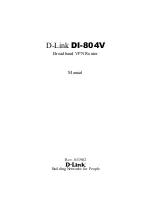
Basic Programming Model
The following sample code shows the previous steps:
CAUTION
The following code is an assembly code compatible with ARM architecture V6
and V7. This code is developed for the Texas Instruments Code Composer
Studio tool set. It is a draft version, only tested on an emulated environment.
; bit field mask to get only the bit field
ACTIVEPRIO_MASK .equ 0x7F
_IRQ_ISR:
; Step 1 : Save the critical context
STMFD SP!, {R0-R12, LR} ; Save working registers
MRS R11, SPSR ; Save the SPSR into R11
; Step 2 : Save the INTC_THRESHOLD register into R12
LDR R0, INTC_THRESHOLD_ADDR
LDR R12, [R0]
(1) The priority-
threshold mechanism is enabled automatically when writing a priority in the range of 0x00 to
0x7F. Writing a value of 0xFF (reset default) disables the priority-
threshold mechanism. Values between 0x3F and 0xFF must not be used. When the hardware-
priority threshold is in use, the priorities of interrupts selected as FIQ or IRQ become linked
otherwise, they are independent. When they are linked, all FIQ priorities must be set higher than
all IRQ priorities to maintain the relative priority of FIQ over IRQ.
(2) When handling FIQs using the priority-
threshold mechanism, both NEWFIQAGR and NEWIRQAGR bits must be written at the same time to ensure
that the new priority threshold is applied while an IRQ sort is in progress. This IRQ will not
have been seen by the ARM, as it will have been masked on entry to the FIQ ISR. However, the
source of the IRQ remains active and it is finally processed when the priority threshold falls to
a priority sufficiently low to allow it to be processed. The precaution of writing to New FIQ
Agreement is not required during an IRQ ISR, as FIQ sorting is not affected (provided all FIQ
priorities are higher than all IRQ priorities).
; Step 3 : Get the priority of the highest priority active IRQ
LDR R1, INTC_IRQ_PRIORITY_ADDR/INTC_FIQ_PRIORITY_ADDR
LDR R1, [R1] ; Get the INTC_IRQ_PRIORITY/INTC_FIQ_PRIORITY register
AND R1, R1, #ACTIVEPRIO_MASK ; Apply the mask to get the priority of the IRQ
STR R1, [R0] ; Write it to the INTC_THRESHOLD register
; Step 4 : Get the number of the highest priority active IRQ
LDR R10, INTC_SIR_IRQ_ADDR/INTC_SIR_FIQ_ADDR
LDR R10, [R10] ; Get the INTC_SIR_IRQ/INTC_SIR_FIQ register
AND R10, R10, #ACTIVEIRQ_MASK ; Apply the mask to get the active IRQ number
; Step 5 : Allow new IRQs and FIQs at INTC side
MOV R0, #0x1/0x3 ; Get the NEWIRQAGR and NEWFIQAGR bit position
LDR R1, INTC_CONTROL_ADDR
STR R0, [R1] ; Write the NEWIRQAGR and NEWFIQAGR bit
; Step 6 : Data Synchronization Barrier
MOV R0, #0 MCR P15, #0, R0, C7, C10, #4
; Step 7 : Read-modify-write the CPSR to enable IRQs/FIQs at ARM side
MRS R0, CPSR ; Read the status register
BIC R0, R0, #0x80/0x40 ; Clear the I/F bit
MSR CPSR, R0 ; Write it back to enable IRQs
; Step 8 : Jump to relevant subroutine handler
LDR PC, [PC, R10, lsl #2] ; PC base address points this instr 8
NOP ; To index the table by the PC
; Table of handler start addresses
.word IRQ0handler ;IRQ0 BANK0
.word IRQ1handler
.word IRQ2handler
195
SPRUH73H – October 2011 – Revised April 2013
Interrupts
Copyright © 2011–2013, Texas Instruments Incorporated
















































